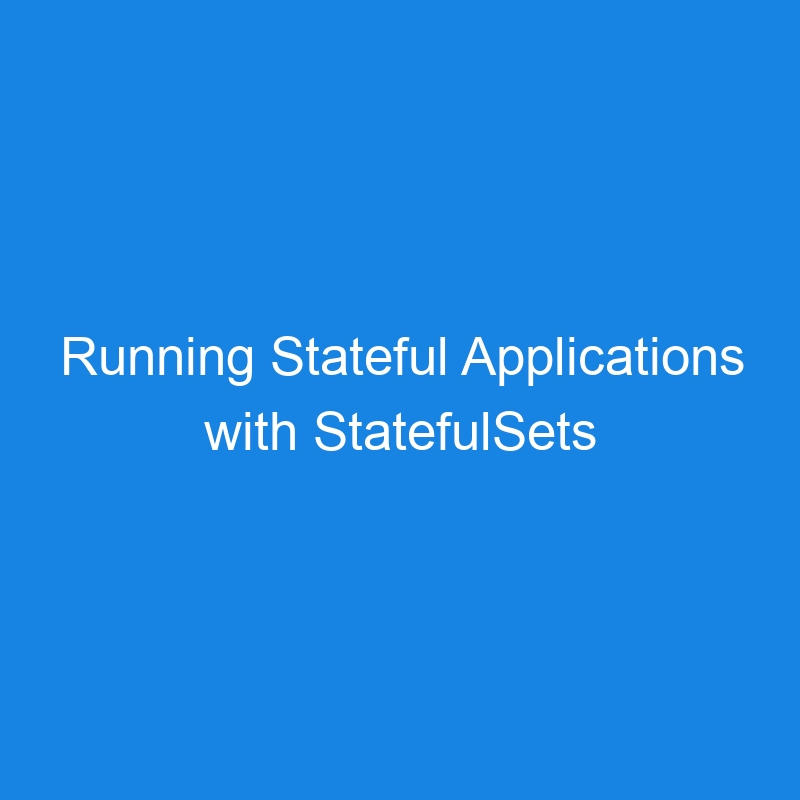Running Stateful Applications with StatefulSets in Kubernetes
In Kubernetes, StatefulSets are a controller used to manage stateful applications. Unlike Deployments (which are typically used for stateless applications), StatefulSets provide guarantees about the ordering and uniqueness of pods, making them ideal for applications that require persistent storage and stable network identities, such as databases, caches, or distributed systems.
Key Features of StatefulSets:
-
Stable, unique network identifiers: Each pod in a StatefulSet has a unique identity that remains stable across restarts. For example, a pod’s hostname will always be
pod-name-0,pod-name-1, etc. - Stable storage: StatefulSets can be used in conjunction with PersistentVolumes to ensure that data is retained even when pods are rescheduled or restarted.
- Ordered, graceful deployment and scaling: Pods in a StatefulSet are created and deleted in a specific order, ensuring that each pod is initialized and terminated sequentially.
Steps for Running Stateful Applications with StatefulSets
1. Define the StatefulSet
To define a StatefulSet, you need to create a YAML configuration file. Below is an example of a StatefulSet definition for a Redis cluster, where each Redis instance will use a persistent volume.
# redis-statefulset.yaml
apiVersion: apps/v1
kind: StatefulSet
metadata:
name: redis
spec:
serviceName: "redis"
replicas: 3
selector:
matchLabels:
app: redis
template:
metadata:
labels:
app: redis
spec:
containers:
- name: redis
image: redis:6.0
volumeMounts:
- name: redis-data
mountPath: /data
volumeClaimTemplates:
- metadata:
name: redis-data
spec:
accessModes: ["ReadWriteOnce"]
resources:
requests:
storage: 1Gi
Explanation:
- serviceName: A headless service is created to give each pod in the StatefulSet a stable DNS name.
- replicas: Specifies the number of pod replicas (in this case, 3 Redis instances).
- volumeClaimTemplates: This ensures that each pod in the StatefulSet gets its own PersistentVolumeClaim for data storage, providing stateful storage.
2. Apply the StatefulSet
You can apply the YAML definition to your Kubernetes cluster:
kubectl apply -f redis-statefulset.yaml
This command will create the StatefulSet along with the corresponding PersistentVolumeClaims and pods.
3. Create a Headless Service
A headless service is required to ensure each pod in the StatefulSet gets a stable network identity. Here’s how you can define it:
# redis-service.yaml
apiVersion: v1
kind: Service
metadata:
name: redis
spec:
clusterIP: None
selector:
app: redis
ports:
- port: 6379
The clusterIP: None creates a headless service, which makes Kubernetes assign DNS names to the pods based on their index (e.g., redis-0, redis-1, etc.).
4. Accessing the StatefulSet Pods
Once the StatefulSet is deployed, each pod in the StatefulSet can be accessed by its unique name. For example:
redis-0.redisredis-1.redisredis-2.redis
To get the list of pods, run:
kubectl get pods -l app=redis
You can then interact with each pod using its DNS name.
5. Scaling the StatefulSet
StatefulSets support scaling, but the scaling happens in a controlled manner:
kubectl scale statefulset redis --replicas=5
Kubernetes will add pods one by one, respecting the order of the existing pods. The pods will be named redis-3, redis-4, and so on.
6. Managing Persistent Storage
StatefulSets ensure that each pod gets its own persistent storage. When a pod is deleted or rescheduled, Kubernetes will reattach the PersistentVolume from the previous pod to the new pod. This allows the application to retain its data.
7. Deleting a StatefulSet
When deleting a StatefulSet, Kubernetes will follow a controlled process to delete the pods in reverse order. If you want to delete a StatefulSet, run:
kubectl delete statefulset redis
This will delete the StatefulSet and the associated pods, but the persistent volumes will remain unless explicitly deleted.
Use Cases for StatefulSets
- Databases: StatefulSets are perfect for running databases like PostgreSQL, MySQL, MongoDB, and more, as they require stable storage and stable network identities for replication and clustering.
- Distributed Systems: Systems like Apache Kafka, Cassandra, and Elasticsearch benefit from StatefulSets’ ability to provide stable identities and persistent storage for each node.
- Caching Systems: Applications like Redis and Memcached often use StatefulSets to maintain consistent state across distributed caches.
Key Differences Between StatefulSets and Deployments
| Feature | StatefulSet | Deployment |
|---|---|---|
| Pod Identity | Stable and unique (e.g., pod-0) |
Dynamic and ephemeral |
| Persistent Storage | Each pod has its own persistent volume | Volumes are shared or ephemeral |
| Scaling | Ordered scaling (one by one) | Pods can be scaled independently |
| Pod Rescheduling | Pod identity is preserved across rescheduling | Pod identity is not preserved |
| Pod Deletion | Pods are deleted in reverse order | Pods are deleted randomly |
Conclusion
StatefulSets provide a robust way to manage stateful applications in Kubernetes. They ensure that applications that rely on persistent data and stable network identities, like databases and distributed systems, can function efficiently in a cloud-native environment. By combining StatefulSets with PersistentVolumes, Kubernetes can manage stateful workloads with ease, making it ideal for applications that need to maintain state across pod restarts and rescheduling.
